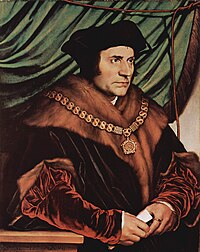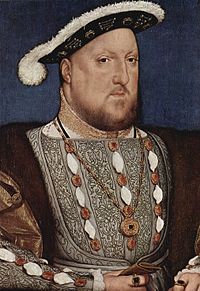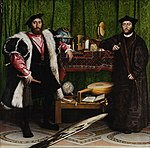Hans Holbein den yngre
| Hans Holbein den yngre | |
 Hans Holbein d.y. - Miniatyr, självporträtt. | |
| Född | ca. 1497 Augsburg |
|---|---|
| Död | 29 november 1543 London |
| Föräldrar | Hans Holbein den äldre |
| Konstnärskap | |
| Fält | Måleri |
| Motiv | Porträtt |
| Rörelse | tysk renässans och Christian IV-stil[1] |
| Redigera Wikidata (för vissa parametrar) | |


Hans Holbein den yngre, född cirka 1497 i Augsburg, Bayern, Tyskland, död 29 november 1543 i London, England, var en framstående tysk och schweizisk målare. Han var son till Hans Holbein den äldre och bror till Ambrosius Holbein.
Holbeins far hade en stor målarverkstad i Augsburg, där han erhöll utbildning. Mycket tidigt tog hand dock intryck av Hans Burgkmair, och influerades genom denne starkt av italiensk renässanskonst. Under en resa till Norditalien 1518-19 fick han ytterligare tillfälle att studera renässansmåleriet.[2]
År 1519 blev Hans Holbein och brodern Ambrosius lärjungar hos en målare i Basel. Holbein blev snart berömd för det arbete han utförde för boktryckarna i Basel. Han kom här att knyta förbindelser inte bara med stadens boktryckare utan även med humanister som Bonifacius Amerbach och Erasmus av Rotterdam. Förutom att han formgav block till träsnitt målade han redan porträtt, beställningar till kyrkor, gjorde väggmålningar med historiska motiv, tecknade utkast till samtidens populära fasadutsmyckningar i al fresco och tecknade dessutom vapenbilder och andra förlagor till glasmålningar. 1522 illustrerade han Lutherbibeln, och hans berömmelse spreds över hela Europa.[2]
Trots sina framgångar drevs Holbein på grund av tvivel på sin ekonomiska framtid under den oordning som rådde under reformationen att söka arbete i England. Under sin första vistelse där 1526-28 gynnades han av kretsen kring Sir Thomas More, vars stöd han vunnit genom ett rekommendationsbrev från Erasmus av Rotterdam. Under denna tid sysslade han främst med porträttmåleri.[2]
Vid sin återkomst till Basel fann han förhållandena mycket osäkra på grund av bildstormarnas verksamhet. Efter fyra år, under vilken tid han främst sysslade med porträtt- och fasadmålning samt företog en resa till Milano återvände Holbein till England 1532, där han sedan kom att verka under återstoden av sitt liv, med undantag för kortare resor till kontinenten.[2]
Då Holbein återvände till England hade de som gynnat honom antingen dött eller råkat i onåd. Han målade till att börja porträtt av tyska handelsmän och presenterades sedan för kung Henrik VIII. Fram till sin död förblev Holbein i den engelske monarkens tjänst.
Holbein tilldelades en rad uppgifter, från att formge hovets dräkter, silver- och juvelsmycken och triumfbågar till att avporträttera kungens aktuella och blivande gemåler. Holbein utförde många teckningar inför sina porträtt, och de som han gjorde av hovdamerna hör till porträttkonstens mästerverk.
Asteroiden 8122 Holbein är uppkallad efter honom.[3]
Verk (i urval)
- Den döde Kristus i graven (1521)
- Erasmus av Rotterdam (1523)
- Venus och Amor (1524)
- Borgmästare Meyers madonna (1526)
- Porträtt av Sir Thomas More (1527)
- Allegori över de Gamla och Nya Testamentena (1530)
- Köpmannen George Gisze (1532)
- Ambassadörerna (1533)
- Henrik VIII (1540)
Galleri
- Porträtt av Bonifacius Amerbach, 1519. Kunstmuseum Basel.
- Den döde Kristus i graven, och en detalj, 1521–22. Kunstmuseum Basel.
- Darmstadt Madonna, omkring 1525-26.
- Lais av Corinth, 1526. Kunstmuseum, Basel
- Porträtt av en dam med en ekorre och en stare, omkring 1527–28. National Gallery, London.
- Porträtt av Georg Gisze, 1532.
- Porträtt av Margaret, Lady Elyot, omkring 1532–34. Kungliga samlingen, Windsor Castle.
- Porträtt av Sir Thomas Elyot, omkring 1532–34. Kungliga samlingen, Windsor Castle.
- Ambassadörerna, 1533. National Gallery, London.
- Porträtt av Jane Seymour, omkring 1537. Kunsthistorisches Museum, Vienna.
- Henry VIII och Henry VII, skiss till väggmålningen i Whitehall, 1537. National Portrait Gallery, London.
Noter
- ^ läs online, www.rct.uk.[källa från Wikidata]
- ^ [a b c d] Carlquist, Gunnar (red.) (1932). Svensk uppslagsbok. Malmö: Svensk Uppslagsbok AB:s förlag, band 13 s. 190-91.
- ^ ”Minor Planet Center 8122 Holbein” (på engelska). Minor Planet Center. https://www.minorplanetcenter.net/db_search/show_object?object_id=8122. Läst 23 oktober 2020.
|
Media som används på denna webbplats
Jean de Dinteville, French Ambassador to the court of Henry VIII of England, and Georges de Selve, Bishop of Lavaur. The painting is famous for containing, in the foreground, at the bottom, a spectacular anamorphic, which, from an oblique point of view, is revealed to be a human skull. An Armenian carpet, a vishapagorg rug from Central Anatolia, is on the table.

Darmstadt Madonna (Madonna of Mayor Jakob Meyer zum Hasen). Limewood, 146.5 ×102 cm, Schlossmuseum, Darmstadt.
Holbein painted the first stage of this work for Jakob Meyer, one of his most important patrons and former mayor of Basel, before he left for England in 1526; he worked again on the painting after returning to Basel in 1528, adding details such as the headdress of Meyer's daughter, Anna, bottom right, representing her betrothal.
By the time this work was painted, the staunchly Catholic Meyer was yesterday's man in Basel, which was coming increasingly under the influence of the Reformation. Holbein was seemingly compliant with the reformers' principles, and this work represents his last orthodox Marian image. The style is a mixture of the realism of early Netherlandish and German painting and, in the treatment of the boys and of the madonna and child, an Italian idealisation. The piece also functions as an epitaph in the Northern tradition. It takes the form of a Madonna of Mercy, a Schutzmantelmadonna, who covers Meyer with a mantle of protection and stands within a scalloped niche. Scholars are divided on whether the boys on the left represent real family members or idealised figures; but it is believed that the three figures on the right are Meyer's first wife, Magdalena Baer (died 1511); second wife, Dorothea Kannengiesser; and daughter Anna. In the view of art historian Jochen Sander (Müller, p. 341): "By combining the most diverse pictorial formulas, and by connecting lifelike portraits with idealised holy figures, in its stupendous handling of the surface and its masterly colourism, this painting belongs among the undisputed masterworks of sixteenth-century European painting".
References
- Oskar Bätschmann & Pascal Griener, Hans Holbein, London: Reaktion Books, 1997, ISBN 1861890400, p. 145.
- Stephanie Buck, Hans Holbein, Cologne: Könemann, 1999, ISBN 3829025831, pp. 76–82.
- Christian Müller; Stephan Kemperdick; Maryan Ainsworth; et al, Hans Holbein the Younger: The Basel Years, 1515–1532, Munich: Prestel, 2006, ISBN 9783791335803, pp. 338–41.
- Derek Wilson, Hans Holbein: Portrait of an Unknown Man, London: Pimlico, Revised Edition, 2006, ISBN 9781844139187, pp. 160–61.
Henry VIII and Henry VII, cartoon for wall painting in Whitehall, 1537. Pen in black, with grey, brown, black, and red wash; paper mounted on canvas, 257.8 × 137.1 cm. National Portrait Gallery, London.
This is the only remaining section of a preparatory drawing Holbein made for a mural at the Palace of Whitehall that included life-sized portraits of Henry VIII, Jane Seymour, Henry VII, and Elizabeth of York. Holbein would have transferred the picture to the wall by pricking holes along the outlines with a needle and blowing or dabbing fine charcoal powder through to mark the surface. The mural, which was destroyed by fire in 1698, is now known through a copy made by Remigius van Leemput in 1667, and through printed versions. The pose struck in this drawing was much copied and became the most famous image of Henry VIII. Holbein's half-length portrait of Henry in this pose is in the Thyssen-Bornemisza Museum, Madrid, but all other surviving versions, which often show the king looking more directly forward, are not by Holbein himself. The king's stance is intentionally heroic, in accordance with the Tudor propaganda inscribed on the stone block in the centre of the mural. At this time, the pose was unusual, since standing with legs apart, though heroic, had been considered impolite; but it was later imitated, for example in portraits of Henry's son and heir, Edward VI. (Reference: Buck, pp. 112–19.)
The Body of the Dead Christ in the Tomb and a detail. olja och temperamåleri på lind, 30.5 × 200 cm, Kunstmuseum Basel.
"Jane Seymour" (1536-1537); Kunsthistorisches Museum, Vienna

























